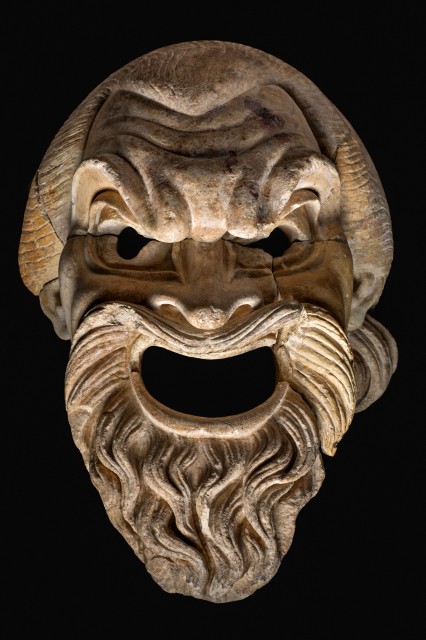Reggio Romana
In the years of reconstruction after World War II, Mario Degani played a fundamental role in supervising construction sites that opened in the center of Reggio. There, he recovered a vast amount of materials dating back to ancient Rome, including a sampling of floor mosaics that were highly interesting. This collection, which was supplemented with finds from digs conducted in the 1980s by the Emilia Romagna Superintendency for Archeological Treasures, found an ideal home in the ancient sacristy of the Church of San Francesco adjoining the Portico dei Marmi, when a section devoted to numismatics, Christian, late antique and medieval archeology opened there in 1996. Its layout was subsequently completed from 1997 to 1998.Roman civilization in Reggio Emilia is illustrated in this section in thematic sequence.
In the first hall, on the left, a fragmented plate mentions Emperor Vespasian, who promoted an important public project (possibly the via Emilia bridge over the Enza River). At the center, we find mosaic flooring in black and white from a domus on the via S. Carlo. Also shown is a reconstructed hypocaust-type heating system and walls built with sesquipedalian bricks, some of which have “built-in handles” or scratches and human prints. The left-hand wall displays a mosaic in black and white with a deep drawer motif, from a domus in the area around Omozzoli Parisetti hospital. Below, a collection of wine and oil amphorae demonstrate intense, lively business activity in the early to the middle Imperial Ages. Locally produced wine amphorae are shown in adjacent showcases. Next, in a selection of kitchen and table pottery, products and imported pieces from the Republican Age are distinguished from items created in the High and Middle Imperial Ages. In the showcases at the center of the area, materials left by the competent archeological Superindendency represent an exception to the latter collection, since they were more recently acquired. They consist of a precious matrix-decorated tumbler by potter Acastus Aco, which was found in the Roman villa at Gambarata di Castellarano; three small bronzes from the Imperial Age depicting Mars, a Lar, and a bust of Flora or Muse, which were found in the towns of Gualtieri, Sant’Ilario and Luceria, respectively; two portrait heads in marble from Novellara; and one small portrait head in limestone from Valle Re in the municipality of Campegine. On the doorposts providing access to the second hall we find statuary fragments: on the left, a figure of a man wearing a toga (with veiled head) from via S. Nicolò; on the right, a loricate from via Caggiati.
A number of themes are illustrated on the other side of the first hall: honorary inscriptions, associated with municipal courts of the Imperial Age; the care of roads and streets (a milestone from Rubiera), and building construction (brick stamps, brick with an inscription commemorating the foundation of a building). A section on religion follows, with inscriptions of dedication to various gods (Fortune, Terminus, Lares), and figurative small bronzes (Minerva, Mercury, Apollo, Hercules, Fortune, Muse). Fragments of sculptures depicting gods (Bacchus, Venus), decorative sculptures (a grotesque fountain mask found in the Roman Garden of a domus) and domestic furnishing elements (a bench support from S. Giorgio villa, a sundial from the old hospital) can be attributed to figurative cultures. Funeral portraiture is represented by a stela of spouses that was obtained from the S. Maurizio necropolis and dates back to the end of the Republican Age. Next, we find portraits from the late Republican Age and the early Imperial Age found in Brescello. On the wall, we can see a perimeter strip in multi-colored mosaic from the area around Omozzoli Parisetti hospital. Below, personal adornment items and furnishings used on a daily basis (instrumentum domesticum) are presented. Worth special mention are two bronze candelabras from the domus on the via S. Carlo. The field of residential building construction is represented by fragments of multi-colored wall decorations and trim for roof decoration (antefixes), in addition to examples of tile flooring, marble plates and opus signinum. The theme of plumbing is illustrated by lead fistulae and terracotta tubuli used for supplying water. Monumental architecture is exemplified by fragments of lacunar ceilings, a section of an arch, capitals and segments of columns. In the second hall, the theme of numismatics is dealt with. Highlighted items include a storage cupboard for aes signatum from Campegine (6th-5th centuries BC); examples of Italic and Roman coinage in bronze (aes grave, 4th century BC); a treasure of Republican denarii and quinarii from Borzano in the municipality of Albinea (1st century BC); examples of Imperial Roman coinage; and a small treasure of denarii and antoniniani that were taken from Quinzio park (3rd century AD).
A small section of Christian archeology includes stelas of Rusticus and Mavarta (6th century AD). Late ancient archeology is documented by a barbarian Roman treasure found in Reggio.
In addition to gold coins, it comprises Roman gold jewelry from the Imperial Age, associated with trinkets hailing from Constantinople and others of barbarian production (end of the 5th century AD). From the High Middle ages (6th and 7th centuries AD) we find grave goods from Longobard tombs in Reggio, from its province, and from Marzaglia (province of Modena). The phalerae and pectoral crosses in gold and silver belonging to the Longobard aristocracy were taken from via Cairoli. Worth noting is a gold tremissis coined in Reggio during the reign of Desiderio and found in Boretto.
Completing the exhibit are glass items and oil lamps from the late Republican and Imperial Ages.
address
via Spallanzani, 1
42121 Reggio Emilia
T. +39 0522 456816
offices
via Palazzolo, 2
42121 Reggio Emilia
T. +39 0522 456477
F. ’39 0522 456476

